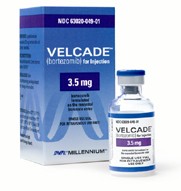
Recently Diagnosed or Relapsed? Stop Looking For a Miracle Cure, and Use Evidence-Based Therapies To Enhance Your Treatment and Prolong Your Remission
Multiple Myeloma an incurable disease, but I have spent the last 25 years in remission using a blend of conventional oncology and evidence-based nutrition, supplementation, and lifestyle therapies from peer-reviewed studies that your oncologist probably hasn't told you about.
Click the orange button to the right to learn more about what you can start doing today.
- You are here:
- Home »
- Blog »
- Multiple Myeloma »
- Velcade/Bortezomib- CIPN, Heart, Blood, Muscle Damage
Velcade/Bortezomib- CIPN, Heart, Blood, Muscle Damage

“Although peripheral neuropathy and myelosuppression have been recognized as the most relevant bortezomib-related adverse effects, cardiac and skeletal muscle toxicities are relatively common in myeloma treated patients, but they have received much less attention.”
Velcade/Bortezomib- Multiple Myeloma killer and nerve, heart, muscle killer, both at the same time. What is a MM patient, survivor to do!?!? While chemotherapy-induced peripheral neuropathy (CIPN) and myelosuppression are the most common and well-known long-term side effect of Velcade, the research linked below lists a frightening group of serious short, long-term and late stage side effects.
After reading the study linked below, you’ve got to ask yourself if high-dose chemo, aggressive chemo and more chemo for the relapsed/refractory MM survivor is the answer to successfully treating multiple myeloma (MM). Keep in mind that I talk about “successfully” treating MM, I’m talking about both quantity of life and quality of life.
Please don’t misunderstand me. I am not saying that chemotherapy is bad or is evil across-the-board bad for all MM patients last all stages of disease. I am not saying that at all.
What I am saying is that:
- Chemotherapy, Velcade in particular, is very toxic stuff.
- Multiple Myeloma can be an aggressive type of cancer
- Velcade/bortezomib, carefully administered in small doses, is necessary to kill MM
That may be easy for me to say but what do I mean? What am I saying…specifically?
The greatest achievement, in my experience anyway, of conventional MM treatment over the past 25 years is the ability of oncology to stabilize the average newly diagnosed MM (NDMM) patient. I say this because according to research, 95% of NDMM is diagnosed at stage 2 or 3.
Further, the standard-of-care induction therapy for NDMM is RVD/VRD aka velcade, revlimid and dexamethasone. It is this induction that causes nearly 100% response in NDMM. I believe it is this induction combo, RVD, that does a remarkably good job at stabilizing NDMM.
Unfortunately, stabilizing patients is great but conventional oncology takes the “maximum tolerated dose” philosophy too far once the MM patient is stabilized.
The solution, again in my opinion, is to switch from RVD as a high-dose chemotherapy triplet to low-dose maintenance combined with both complementary and integrative therapies.
To learn more about the chemotherapy called Velcade/bortezomib-
- Can Velcade Bortezomib ReChallenge Myeloma?
- Myeloma – Velcade- Nerve
- Myeloma Chemo- Bortezomib vs. Lenalidomide
- Myeloma- IVC, IV Peroxide, Ozone w/ Bortezomib?
- DCA enhances Velcade in Myeloma
To learn more about “complementary” and/or “integrative” therapies, scroll down the page, post a question or a comment and I will reply to you ASAP.
Multiple Myeloma – Stage 3
Thank you,
David Emerson
- MM Survivor
- MM Cancer Coach
- Director PeopleBeatingCancer
Recommended Reading:
- MM Dx, MM CC, Induction, ASCT, Healing, Surviving-Now What?
- Multiple Myeloma Side Effects- Prevention of Nerve Damage
- Multiple Myeloma Side Effects-Chemo-induced, Radiation-induced Muscle Atrophy
Non-Hematologic Toxicity of Bortezomib in Multiple Myeloma: The Neuromuscular and Cardiovascular Adverse Effects
“Multiple myeloma (MM) is a still uncurable tumor of mainly elderly patients originating from the terminally differentiated B cells. Introduction to the treatment of MM patients of a new class of drugs called proteasome inhibitors (bortezomib followed by carfilzomib and ixazomib) significantly improved disease control.
Proteasome inhibitors interfere with the major mechanism of protein degradation in a cell leading to the severe imbalance in the protein turnover that is deadly to MM cells.
Currently, these drugs are the mainstream of MM therapy but are also associated with an increased rate of the injuries to multiple organs and tissues…
The first-in-class selective PI bortezomib has been initially approved for the refractory forms of the disease but has now become, in combination with other drugs, the backbone of the frontline therapy for newly diagnosed MM patients, as well as in the maintenance therapy and relapsed/refractory setting.
Despite being among the most widely used and highly effective agents for MM, bortezomib can induce adverse events that potentially lead to early discontinuation of the therapy with negative effects on the quality of life and outcome of the patients.
Although peripheral neuropathy and myelosuppression have been recognized as the most relevant bortezomib-related adverse effects, cardiac and skeletal muscle toxicities are relatively common in MM treated patients, but they have received much less attention…
Proteasome inhibitors (PIs) have been proved to be effective in MM patients and include the first-in-class PI bortezomib, the second-generation inhibitor carfilzomib, and ixazomib, the first oral PI [10]…
Bortezomib: The First-in-Class Proteasome Inhibitor
The introduction of bortezomib (also known as PS 341 and Velcade™), approved by the US Food and Drug Administration (FDA) in 2003, represented a breakthrough in the treatment of MM…
Despite being among the most widely used and highly effective treatment options for MM, bortezomib can induce adverse events that potentially lead to early discontinuation of the therapy with a negative impact on the quality of life and outcome of the patients (Figure 2). The drug is available for intravenous injection or subcutaneous use [28].
Based on data from the multicenter phase II open-label, single-arm (SUMMIT) trial, which led to the FDA approval of the drug, the most frequently reported all-grade side effects were asthenic conditions including
- fatigue and weakness (52%),
- nausea (55%),
- diarrhea (44%),
- thrombocytopenia (40%),
- peripheral neuropathy (31%),
- vomiting (27%),
- anorexia (25%),
- pyrexia (22%)
- and anemia (21%) [29].
The major grade 3 adverse reactions included thrombocytopenia (28%), fatigue (12%), neuropathy (12%), and neutropenia (11%), and fourteen percent of the patients experienced at least one episode of severe toxicity (grade 4), most commonly hematologic including thrombocytopenia (3%) and neutropenia (3%) [29]…
Peripheral Neuropathy: The Key Dose-Limiting Toxicity
Peripheral neuropathy represents one of the most common, unpredictable, and dose-limiting non-hematologic adverse events of MM treatment with bortezomib, which often requires dose modification, delay, or discontinuation of the drug. Bortezomib-induced peripheral neuropathy (BIPN) negatively affects clinical endpoints with a detrimental effect on the quality of life of patients and is associated with a significant economic impact, which adds up to the costs directly related to disease therapy [31,32]…
“…33 patients with multiple myeloma at first diagnosis, to evaluate whether a nutraceutical compound given for 6 months during bortezomib (BTZ) treatment succeeded in preventing the onset of neurotoxicity.”
Burning, tingling and pain can result as a symptom of multiple myeloma or as a side effect generally termed chemotherapy-induced peripheral neuropathy (CIPN). Newly diagnosed MM patients undergoing bortezomib (velcade) can develop BIPN or bortezomib-induced nerve damage.
This blog post focuses on the study discussed below. The study focuses on the prevention of BTZ in newly diagnosed multiple myeloma patients.
Previous blog post written on the subject of CIPN generally or BIPN specifically have discussed therapies ranging from acupuncture to LLLT to CBD oil.
- Multiple Myeloma-BIPN aka Nerve Damage
- Velcade for Myeloma – Therapies for Nerve Pain?
- Multiple Myeloma Side Effects, Pain and C-B-D oil
- Multiple Myeloma Side Effects- Acupuncture For Pain
Speaking as a MM survivor and MM coach, I can say that the majority of newly diagnosed MM patients are not thinking about possible short, long-term and late stage side-effects when they are first diagnosed with MM. Oncology will push MM patients into therapy without giving a thought to pre-habilitation in general or side effect specific nutraceuticals like the ones discussed below.
The challenge then, is for the MM patient suffering from BIPN to try all possible evidence-based BIPN in hopes of reducing or eliminating his/her MM side effect.
David Emerson
- MM Survivor
- MM Coach
- Director PeopleBeatingCancer
Recommended Reading:
- Prevention of chemotherapy-induced peripheral neuropathy
- Multiple Myeloma Side Effects- BIPN, Acupuncture, Relief?
- Myeloma Side Effect- Chemotherapy-induced Peripheral Neuropathy!
The Effect of Docosahexaenoic Acid and α-Lipoic Acid as Prevention of Bortezomib-Related Neurotoxicity in Patients With Multiple Myeloma
” In cancer patients, a common complication during chemotherapy is chemotherapy-induced peripheral neuropathy (CIPN). For this reason, we decided to conduct a phase II prospective study on 33 patients with multiple myeloma at first diagnosis, to evaluate whether a nutraceutical compound given for 6 months during bortezomib (BTZ) treatment succeeded in preventing the onset of neurotoxicity.
Methods: Neurological evaluation, electroneurography, and functional and quality of life (QoL) scales were performed at baseline and after 6 months. We administered a tablet containing docosahexaenoic acid 400 mg, α-lipoic acid 600 mg, vitamin C 60 mg, and vitamin E 10 mg bid for 6 months.
Results: Concerning the 25 patients who completed the study, at 6-month follow-up, 10 patients had no neurotoxicity (NCI-CTCAE [National Cancer Institute-Common Terminology Criteria for Adverse Events] = 0), while 13 progressed to NCI-CTCAE grade 1, 1 had NCI-CTCAE grade 1 with pain, and 1 experienced a NCI-CTCAE grade 2. Painful symptoms were reported only in 2 patients, and we observed stability on functional and QoL scales in all patients. None of the 25 patients stopped chemotherapy due to neurotoxicity.
Conclusions: Our data seem to indicate that the co-administration of a neuroprotective agent during BTZ treatment can prevent the appearance/worsening of symptoms related to CIPN, avoiding the interruption of BTZ and maintaining valuable functional autonomy to allow normal daily activities. We believe that prevention remains the mainstay to preserve QoL in this particular patient population, and that future studies with a larger patient population are needed.




